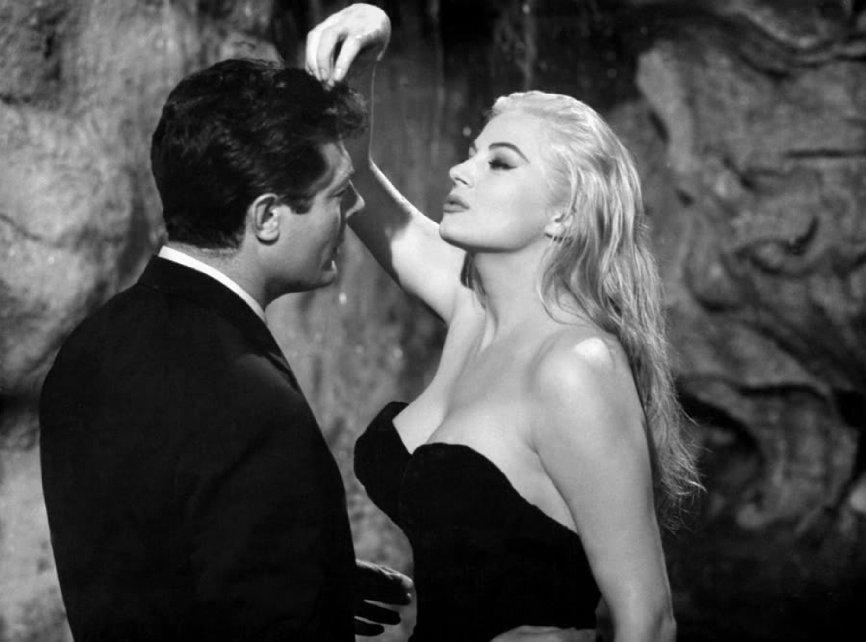With La Dolce Vita (1960), director Federico Fellini submitted a singular classic. True, considered strictly as a film—as a three-hour film starring Marcello Mastroianni as a gossip reporter with perfect hair—it is tediously baggy, a movie “about the boredom of boring people” provisionally employed in “the various whoring professions,” to quote David Thomson. But judged as an art installation about a high-gloss demimonde fidgeting on the runway of the jet-set era, it is to die for—a foundational text of the multi-national entertainment state in which we all jumpily dwell.
Here, Fellini gave the world the word paparazzi; gave composer Nino Rota occasion for a perfect score; gave Woody Allen ideas both good (for Stardust Memories, especially the parts featuring Charlotte Rampling) and horrid (for Celebrity, specifically all the parts not featuring Leonardo DiCaprio); and gave to young men who come down from good universities into a certain segment of journalism a myth of their tortured selves second only to that of Sweet Smell of Success.
Not least, he gave us a vision of actress Anita Ekberg—dead Sunday at 83—as a bombshell about bombshell, a gossamer vision of beauty and beautiful untruth.
A deeply Roman Catholic film, La Dolce Vita is unsubtle in a thoroughly Roman Catholic way. It begins with a statue of Jesus Christ rigged to a helicopter motoring over Rome and proceeds to feature, with deluxe depth of field, nuns, virgins, sinners, saints, Dante homages, and the ruins of two millennia.
Is Ekberg, playing a Swedish-American movie star named Sylvia, the most gloriously freighted symbol of all? Yes, probably: She is woman; she is goddess; she is your permanent crush.
She enters from an Alitalia jet—the incarnation of a dream of a starlet—gaining the airstairs with a regal wave of a palm, a ditzy turn of the lips, a divine plushness all over, and the hint of a smarter self hidden behind cat’s-eye sunglasses. The entertainment press proffer flowers and pizza. A paparazzo licks predatory chops, saying to the hero, “Great piece of meat, huh?” She sparkles through a giddy press conference with a glib media, sulks at a big party with a bad boyfriend, and sizzles through a melancholy tour of the decadent night with the hero, elaborating a choreographed flirtation.
They make their way to Trevi Fountain for one of those love scenes so indelible that its memory will flow, even among people who haven’t seen the film, from here to eternity: Sylvia has a snowy fur draped over her strapless black gown, and a snowy kitten perched atop her white-blonde head as if to suggest that there’s maybe a kitten inside her head as well. Such fluff. Dissolve.
She strides into the fountain like a wood nymph fording a brook to shower in the sound of the running water. Marcello—“we’re all making a mistake,” he says to himself—follows and approaches. She anoints his head with water. He moves his lips toward hers. And as the fountain shuts down as the sun comes up, we witness what is perhaps the greatest non-kiss in the history of cinema. What does it mean? (What do you care?) It means delay, desire, the defusing of a sex bomb. Day breaks and a dream diffuses.
Will we see Ekberg’s kind again? Inasmuch as her Sylvia is an archetype of alluring beauty: Yeah, sure. But given that stars of her peculiar type are relics of both a bygone cinema culture and an antique movie-industry structure: No, sorry. In 1956, four years before La Dolce Vita, Ekberg won a “promising newcomer” Golden Globe. Last night’s telecast of that meat parade involved a L’Oreal commercial invoking one of Ekberg’s few superiors in the international-sex-kitten game. We were advertised a hair dye “inspired by the legendary hair color of Sophia Loren.” Huh? I am not sure that Ms. Loren, 80, could identify what exact shade her hair was in that sweet age of life when she established her legend. But the aura of the era colors everything.
